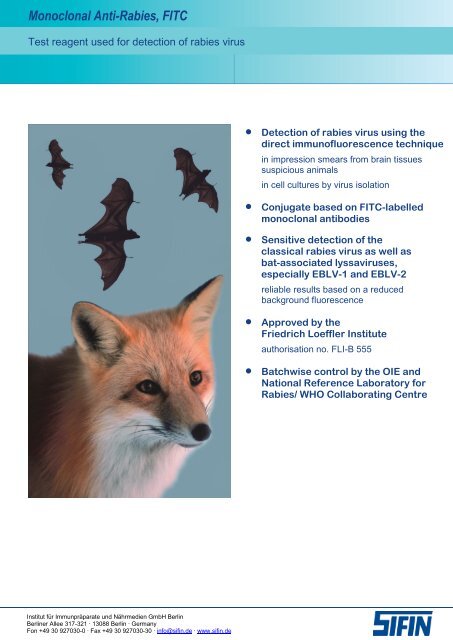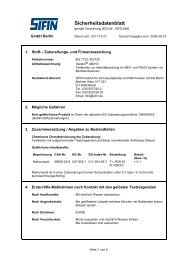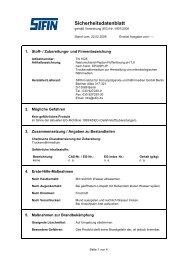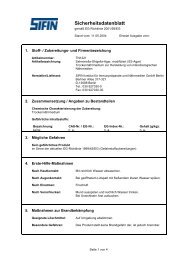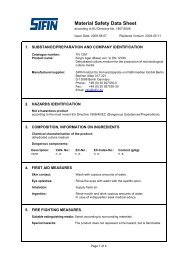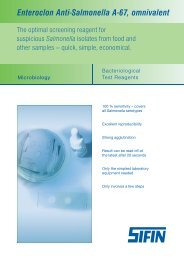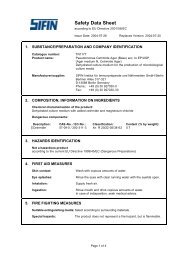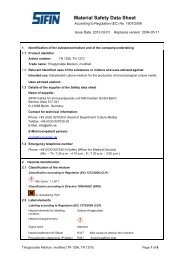Monoclonal Anti-Rabies, FITC - SIFIN
Monoclonal Anti-Rabies, FITC - SIFIN
Monoclonal Anti-Rabies, FITC - SIFIN
Create successful ePaper yourself
Turn your PDF publications into a flip-book with our unique Google optimized e-Paper software.
<strong>Monoclonal</strong> <strong>Anti</strong>-<strong>Rabies</strong>, <strong>FITC</strong><br />
Test reagent used for detection of rabies virus<br />
Institut für Immunpräparate und Nährmedien GmbH Berlin<br />
Berliner Allee 317-321 ∙ 13088 Berlin ∙ Germany<br />
Fon +49 30 927030-0 ∙ Fax +49 30 927030-30 ∙ info@sifin.de ∙ www.sifin.de<br />
Detection of rabies virus using the<br />
direct immunofluorescence technique<br />
in impression smears from brain tissues<br />
suspicious animals<br />
in cell cultures by virus isolation<br />
Conjugate based on <strong>FITC</strong>-labelled<br />
monoclonal antibodies<br />
Sensitive detection of the<br />
classical rabies virus as well as<br />
bat-associated lyssaviruses,<br />
especially EBLV-1 and EBLV-2<br />
reliable results based on a reduced<br />
background fluorescence<br />
Approved by the<br />
Friedrich Loeffler Institute<br />
authorisation no. FLI-B 555<br />
Batchwise control by the OIE and<br />
National Reference Laboratory for<br />
<strong>Rabies</strong>/ WHO Collaborating Centre
Application<br />
<strong>Monoclonal</strong> <strong>Anti</strong>-<strong>Rabies</strong>, <strong>FITC</strong>, is used for<br />
detection of rabies virus in impression smears<br />
from brain tissues of animals and by virus<br />
isolation in cell cultures.<br />
Composition<br />
<strong>Monoclonal</strong> <strong>Anti</strong>-<strong>Rabies</strong>, <strong>FITC</strong>, contains fluorescein<br />
isothiocyanate (<strong>FITC</strong>)-labelled monoclonal<br />
antibodies which are isolated from cell culture<br />
supernatants. The product is lyophilized.<br />
Methods<br />
1. Detection of rabies virus in impression<br />
smears<br />
The test is normally performed using sample<br />
material obtained from animals suspected of<br />
having rabies.<br />
1.1.Prepare the working dilution on the day of<br />
use by mixing <strong>Monoclonal</strong> <strong>Anti</strong>-<strong>Rabies</strong>,<br />
<strong>FITC</strong>, dissolved in 1 ml distilled water with<br />
PBS-buffer. Working dilutions of 1:15 to 1:20<br />
are recommended. The user has to be<br />
determined the optimal working dilution for<br />
its own test conditions.<br />
1.2.Use slides to prepare impression smears<br />
from different parts of the brain.<br />
1.3.Fix the slides by quickly drawing them<br />
through the nonluminous flame of a Bunsen<br />
burner 3 times.<br />
1.4.Coat the slides with <strong>Monoclonal</strong> <strong>Anti</strong>-<br />
<strong>Rabies</strong>, <strong>FITC</strong>, working dilution.<br />
1.5.Incubate the slides in a humid chamber at<br />
37 °C for 30 min..<br />
1.6.Afterwards, pour off the liquid and wash the<br />
slides by immersing them in PBS 3 times for<br />
5 min. each.<br />
1.7.Briefly rinse the slides with water and allow<br />
them to air dry. Once dry, mount the slides<br />
on a fluorescence microscope and examine<br />
fluorescence.<br />
2. Isolation of rabies virus in cell culture<br />
The isolation of rabies virus in cell culture is<br />
carried out as specified in the testing labs<br />
own protocol.<br />
The level of dilution of <strong>Monoclonal</strong> <strong>Anti</strong>-<br />
<strong>Rabies</strong>, <strong>FITC</strong>, is determined by the user.<br />
Working dilutions of 1:15 to 1:20 are<br />
recommended.<br />
Interpretation of the results<br />
The prepared slides are examined using a<br />
suitable fluorescence microscope with or<br />
without oil immersion, as needed.<br />
Positive result (+)<br />
Positive samples have nearly round particles of<br />
various size which exhibit a bright yellow-green<br />
fluorescence, that is easy to discern from the<br />
dull green fluorescence of the surrounding<br />
tissue; a halo-like rim of fluorescence can often<br />
be observed. The background tissue should<br />
exhibit only dull grey-green fluorescence.<br />
Negative result (-)<br />
The absence of particles exhibiting a bright<br />
yellow-green fluorescence against a dull greygreen<br />
fluorescence background indicates the<br />
absence of rabies virus.<br />
Date of revision: November 2011<br />
<strong>Monoclonal</strong><br />
<strong>Anti</strong>-<strong>Rabies</strong>, <strong>FITC</strong><br />
description code package size<br />
<strong>Monoclonal</strong> <strong>Anti</strong>-<strong>Rabies</strong>, <strong>FITC</strong><br />
Liquid bulk quantities on request<br />
Reaction pattern<br />
PA 1202<br />
1 ml lyophilized<br />
<strong>Rabies</strong> virus <strong>Monoclonal</strong> <strong>Anti</strong>-<strong>Rabies</strong>, <strong>FITC</strong><br />
European fox strain<br />
Atypical fox variant<br />
Dog-mediated strains<br />
Polar strains<br />
Oral rabies virus vaccine strain<br />
Laboratory strains<br />
Mokola virus<br />
Lagos bat virus<br />
Duvenhage virus<br />
EBLV-1<br />
EBLV-2<br />
Please contact Ronald Rasche (rasche@sifin.de) for more information or visit<br />
www.sifin.de.<br />
++<br />
++<br />
++<br />
++<br />
+<br />
++<br />
++<br />
++<br />
++<br />
++<br />
++<br />
Reaction strengh: ++ strong reaction, + weak reaction


